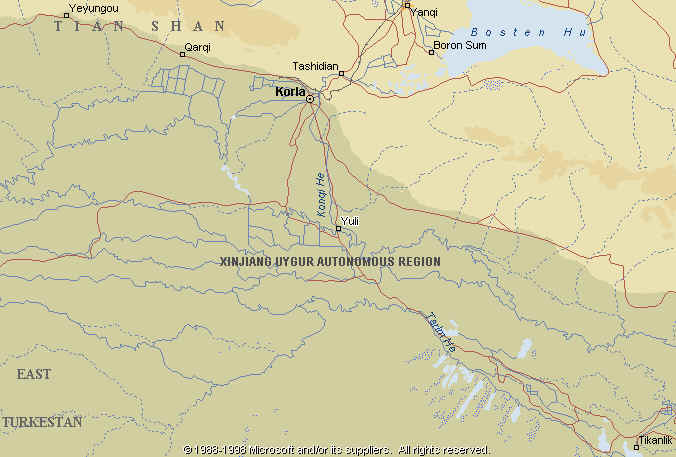
Reconstruction of the Niya Bow
Stephen Selby
In June 1999, I had the opportunity to visit an exhibition of 'Treasures of the Silk Route' at the Revolutionary Museum in Beijing, China. The exhibition included artifacts, fabrics and human mummies excavated in the super-dry desert sands of the silk route. All were in an outstanding state of preservation.
Two bows were featured in the exhibition. Both dated from the late Han/Jin period (about 200-300AD). One of the bows, although probably very interesting, had not been removed from its quiver, so there was no way to examine it. The other, however, was out of its quiver and so well preserved that the original gut string was still in position, although the limbs have been warped.
At the time of the exhibition there was no catalogue, and (quite rightly) I was not permitted to take flash photographs. However, a finely-printed catalogue has subsequently been published (in Chinese and English):
"Archaeological Treasures of the Silk Road in Xinjiang Uygur Autonomous Region" Ed. Ma Chengyuan, Yue Feng. Shanghai Publishing Translation House, 1998. ISBN 7-5327-2145-0/G.066 Before leaving Shanghai, I obtained permission from the publisher to scan the photograph of the bow on page 142 to discuss with experts by email: but not for publication. The bow has aroused great excitement, particularly because it appears to verify Hungarian reconstructions of early Hun bows done by Professor Gyula László. Chris Szabo has particularly expressed an interest in discussing the bow.To overcome the copyright problem, I have now created my own reconstruction of the Niya bow, based both on my observations at the Museum and on the photograph in the published catalogue. I also drew upon the illustration in Chris Szabo's article.
The title of the photograph in the catalogue is as follows: "Han to Jin (3rd Century BC to 5th Century AD) Excavated from Tomb No. 30 at Yingpan, Yuli County in 1995.) In the collection of the Archaeology Institute of Xinjiang Uygur Autonomous Region."

Bow: Length: 130 cm. Width: 0.6 cm - 3.2 cm. Thickness: 0.6 cm - 4.6 cm. Arrow: Length: 73.5 cm.
Graphical reconstruction of the Niya Bow by Stephen
Selby.
This picture (but not the map above it) is placed in the public domain:
it can be copied and made available on the Internet other than for commercial
purposes, and with sufficient acknowledgement.
Stephen’s own observations.
I saw this bow and arrow set on display in June 1999 at the Revolutionary Museum, Beijing. It is in strikingly good condition, the main defect being deformation of the limbs.
The overall construction struck me as typical Asiatic bow construction. Horn, wood and sinew layers were visible, applied in the normal fashion.
The original grip is very narrow. I speculate that there was some further wrapping around it, though given the excellent preservation of the bow, I would expect any wrapping to have been found. My reconstruction incorporates soft leather wrapping on the grip which was not in the original.
The flat bone strips attached to the sides of the sayahs are identical to sets on display at the Mongolian Military Museum in Ulaanbaatar, where they are described as Hun bow-tip reinforcements. (I have a single example myself, illustrated below.)

In the Mongolian National Museum of History in Ulaanbaatar, however, identical items are also described as Hun, but were simply described as ‘ornaments’, as if for jewelry.
I cannot form a judgment as to whether the segments of the limbs from the base of the bone reinforcement to the joints with the limbs were intended to bend (see insert below): however, they are so thin that I cannot see how they would have failed to do so. I am not certain whether there was horn or sinew applied to those parts.

Last up-dated: February 03, 2001